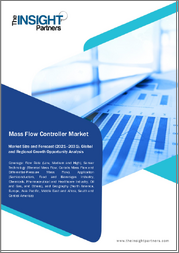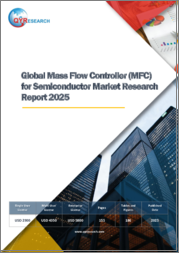
|
시장보고서
상품코드
1577053
매스 플로우 컨트롤러 시장, 기회, 성장 촉진요인, 산업 동향 분석과 예측(2024-2032년)Mass Flow Controller Market, Opportunity, Growth Drivers, Industry Trend Analysis and Forecast, 2024-2032 |
||||||
세계의 매스 플로우 컨트롤러(MFC) 시장은 2023년에 12억 1,000만 달러로 평가되며, 2024-2032년 5.5% 이상의 CAGR로 성장할 것으로 예측됩니다.
이러한 성장의 주요 원인은 특히 신흥 국가들의 반도체 제조에 대한 막대한 투자에 있습니다. 각국 정부는 세제 혜택, 인프라 구축, 연구 보조금 등을 통해 지역 기술 역량을 강화하기 위해 노력하고 있습니다. 이러한 노력은 반도체 제조 공장을 설립하려는 국내외 기업을 유치하기 위한 것으로, 반도체 제조에서 정밀한 가스 및 화학 물질의 흐름을 조절하는 데 필수적인 MFC에 대한 수요를 증가시키고 있습니다. 이러한 현지 생산에 대한 집중은 수입 의존도를 낮추고, 공급망을 강화하며, 숙련된 일자리를 창출하는 등 다양한 경제적 효과를 가져옵니다.
MFC는 반도체 분야뿐만 아니라 재생에너지 분야에서도 MFC의 채택이 증가하고 있습니다. 수소 생산, 바이오가스, 연료전지 등의 산업은 운영 효율에 필수적인 정확한 가스 유량 제어를 위해 MFC에 의존하고 있습니다. 재생에너지 분야가 확대되고 기술 혁신이 진행됨에 따라 이러한 용도에서 신뢰할 수 있고 정밀한 MFC에 대한 수요가 증가할 것으로 예상됩니다.
재료별로 MFC 시장은 스테인리스강과 이국적인 합금으로 나뉘며, 2023년 스테인리스강은 내구성, 우수한 내식성 및 비용 효율성으로 인해 시장 점유율의 74% 이상을 차지했습니다. 스테인리스강은 반도체, 화학 처리, 식품 및 음료 및 기타 산업에서 널리 사용되므로 시장을 주도하고 있습니다. 또한 이국적인 합금에 비해 접근이 용이하고 제조 비용이 낮기 때문에 신뢰할 수 있고 장기적인 성능이 필요한 다양한 산업 용도에 더 쉽게 사용할 수 있는 선택이 되었습니다.
산업별로는 반도체 분야가 2023년 가장 빠른 성장세를 보일 것으로 예상되며, CAGR은 7%를 상회할 것으로 전망됩니다. 이 부문 시장 규모는 2032년까지 5억 달러 이상에 달할 것으로 예상됩니다. 이러한 성장의 원동력은 반도체 제조 기술의 발전과 마이크로 일렉트로닉스 및 집적회로 제조시 정밀한 가스 흐름 제어가 필요한 고성능 전자 장비에 대한 수요 증가에 기인합니다.
2023년 아시아태평양이 MFC 시장을 장악하여 시장 점유율의 57% 이상을 차지할 것으로 예상됩니다. 이 지역의 리더십은 중국, 대만, 일본, 한국 및 기타 국가들이 반도체 제조의 세계 허브로서 매우 중요한 역할을 하고 있기 때문입니다. 이들 국가의 전자 및 하이테크 산업의 급속한 성장은 고급 MFC에 대한 수요를 더욱 증가시키고 있습니다.
목차
제1장 조사 범위와 조사 방법
- 시장 범위와 정의
- 기본 추정과 계산
- 예측 파라미터
- 데이터 소스
- 1차 데이터
- 2차 데이터
- 유료 소스
- 공적 정보원
제2장 개요
제3장 업계 인사이트
- 에코시스템 분석
- 벤더 매트릭스
- 테크놀러지와 혁신 전망
- 특허 분석
- 주요 뉴스와 구상
- 규제 상황
- 영향요인
- 촉진요인
- 산업 자동화 수요의 급증
- 재생에너지 애플리케이션에서 매스 플로우 컨트롤러의 채택 증가
- 수처리·폐수 처리에서 첨단 매스 플로우 컨트롤러의 수요 증가
- 반도체 제조 개발도상국을 지원하는 정부 구상
- 제약·헬스케어 산업에서 첨단 기기 제조에 대한 지속적 투자
- 업계의 잠재적 리스크 & 과제
- 매스 플로우 컨트롤러에 대한 고액의 초기 투자
- 차압 MFC의 변동에 의해 유량 계측에서 오프셋이 발생할 가능성
- 촉진요인
- 성장 가능성 분석
- Porter의 산업 분석
- PESTEL 분석
제4장 경쟁 구도
- 기업 점유율 분석
- 경쟁 포지셔닝 매트릭스
- 전략 전망 매트릭스
제5장 시장 추산·예측 : 재료 유형별, 2021-2032년
- 주요 동향
- 스테인리스강
- 이그조틱 합금
제6장 시장 추산·예측 : 유량별, 2021-2032년
- 주요 동향
- 저유량
- 중유량
- 고유량
제7장 시장 추산·예측 : 제품 유형별, 2021-2032년
- 주요 동향
- 차압식 유량계
- 열식 질량 유량계
- 코리올리식 매스 플로우 미터
제8장 시장 추산·예측 : 접속 기술별, 2021-2032년
- 주요 동향
- 아날로그
- Profibus
- RS-485
- Profinet
- EtherCAT
- Ethernet/IP
- Modbus RTU
- DeviceNet
- Foundation fieldbus
제9장 시장 추산·예측 : 업계별, 2021-2032년
- 주요 동향
- 석유 및 가스
- 제약
- 식품 및 음료
- 화학
- 헬스케어·생명과학
- 반도체
- 상하수도 치료
- 기타
제10장 시장 추산·예측 : 지역별, 2021-2032년
- 주요 동향
- 북미
- 미국
- 캐나다
- 유럽
- 영국
- 독일
- 프랑스
- 이탈리아
- 스페인
- 기타 유럽
- 아시아태평양
- 중국
- 인도
- 일본
- 한국
- 뉴질랜드
- 기타 아시아태평양
- 라틴아메리카
- 브라질
- 멕시코
- 기타 라틴아메리카
- 중동 및 아프리카
- UAE
- 사우디아라비아
- 남아프리카공화국
- 기타 중동 및 아프리카
제11장 기업 개요
- Alicat Scientific
- Axetris AG
- Azbil Corporation
- Bronkhorst High-Tech
- Brooks Instrument
- Burkert Fluid Control Systems
- Dakota Instruments, Inc.
- Dwyer Instruments
- Fcon Co.
- FC-Technik
- Hitachi Metals, Ltd.
- Horiba, Ltd.
- Kelly Pneumatics, Inc.
- Kofloc Kyoto
- MKS Instruments
- NEW-FLOW
- Ohkura Electric Co., Ltd.
- OMEGA Engineering, Inc.
- Parker Hannifin
- Sensirion AG
- Sierra Instruments
- Teledyne Hastings Instruments
- Tokyo Keiso
- Vogtlin Instruments
The Global Mass Flow Controller (MFC) Market was valued at USD 1.21 billion in 2023 and is projected to grow at a compound annual growth rate (CAGR) of over 5.5% from 2024 to 2032. The growth is largely driven by significant investments in semiconductor manufacturing, particularly in developing countries. Governments in these regions are offering tax incentives, building infrastructure, and providing research grants to enhance local technological capabilities. These efforts aim to attract both domestic and international companies to establish semiconductor fabs, which boosts demand for MFCs, essential for regulating precise gas and chemical flows in semiconductor production. This focus on local manufacturing helps reduce import reliance, strengthen supply chains, and generate skilled jobs, offering wider economic benefits.
In addition to the semiconductor sector, the adoption of MFCs in renewable energy applications is increasing. Industries such as hydrogen production, biogas, and fuel cells rely on MFCs for accurate gas flow control, which is crucial for operational efficiency. As the renewable energy sector expands and technological innovations progress, the demand for reliable and precise MFCs in these applications is expected to grow.
Material-wise, the MFC market is divided into stainless steel and exotic alloys. In 2023, stainless steel accounted for over 74% of the market share due to its durability, excellent corrosion resistance, and cost-effectiveness. Stainless steel's widespread use across industries such as semiconductors, chemical processing, and food and beverages solidifies its market leadership. Its availability and lower manufacturing costs compared to exotic alloys also make it a more accessible option for a range of industrial applications requiring reliable and long-term performance.
By industry vertical, the semiconductor segment showed the fastest growth in 2023, with a projected CAGR of over 7%. The market value of this segment is expected to surpass USD 500 million by 2032. The growth is fueled by advancements in semiconductor manufacturing technologies and the rising demand for high-performance electronic devices, which require precise gas flow control during the fabrication of microelectronics and integrated circuits.
In 2023, the Asia Pacific region dominated the MFC market, holding over 57% of the market share. The region's leadership is attributed to its role as a global hub for semiconductor manufacturing, with countries like China, Taiwan, Japan, and South Korea playing pivotal roles. The rapid growth of electronics and high-tech industries in these nations further drives the demand for advanced MFCs.
Table of Contents
Chapter 1 Scope and Methodology
- 1.1 Market scope and definition
- 1.2 Base estimates and calculations
- 1.3 Forecast parameters
- 1.4 Data sources
- 1.4.1 Primary
- 1.4.2 Secondary
- 1.4.2.1 Paid sources
- 1.4.2.2 Public sources
Chapter 2 Executive Summary
- 2.1 Industry 360° synopsis, 2021 - 2032
Chapter 3 Industry Insights
- 3.1 Industry ecosystem analysis
- 3.2 Vendor matrix
- 3.3 Technology and innovation landscape
- 3.4 Patent analysis
- 3.5 Key news and initiatives
- 3.6 Regulatory landscape
- 3.7 Impact forces
- 3.7.1 Growth drivers
- 3.7.1.1 Surge in demand for industrial automation
- 3.7.1.2 Rising adoption of mass flow controllers in renewable energy applications
- 3.7.1.3 Increasing demand for advanced mass flow controllers in water and wastewater treatment
- 3.7.1.4 Government initiatives to boost semiconductor manufacturing developing countries
- 3.7.1.5 Continuous investments in pharmaceuticals and healthcare industries for advanced equipment manufacturing
- 3.7.2 Industry pitfalls and challenges
- 3.7.2.1 High initial investment in mass flow controller
- 3.7.2.2 Variation in differential pressure MFCs can create offset in flow measurement
- 3.7.1 Growth drivers
- 3.8 Growth potential analysis
- 3.9 Porter's analysis
- 3.9.1 Supplier power
- 3.9.2 Buyer power
- 3.9.3 Threat of new entrants
- 3.9.4 Threat of substitutes
- 3.9.5 Industry rivalry
- 3.10 PESTEL analysis
Chapter 4 Competitive Landscape, 2023
- 4.1 Company market share analysis
- 4.2 Competitive positioning matrix
- 4.3 Strategic outlook matrix
Chapter 5 Market Estimates and Forecast, By Material Type, 2021 - 2032 (USD Million and Units)
- 5.1 Key trends
- 5.2 Stainless steel
- 5.3 Exotic alloys
Chapter 6 Market Estimates and Forecast, By Flow Rate, 2021-2032 (USD Million and Units)
- 6.1 Key trends
- 6.2 Low flow rate
- 6.3 Medium flow rate
- 6.4 High flow rate
Chapter 7 Market Estimates and Forecast, By Product Type, 2021 - 2032 (USD Million and Units)
- 7.1 Key trends
- 7.2 Differential pressure flow meter
- 7.3 Thermal mass flow meter
- 7.4 Coriolis mass flow meter
Chapter 8 Market Estimates and Forecast, By Connectivity Technology, 2021 - 2032 (USD Million and Units)
- 8.1 Key trends
- 8.2 Analog
- 8.3 Profibus
- 8.4 RS-485
- 8.5 Profinet
- 8.6 EtherCAT
- 8.7 Ethernet/IP
- 8.8 Modbus RTU
- 8.9 DeviceNet
- 8.10 Foundation fieldbus
Chapter 9 Market Estimates and Forecast, By Industry Vertical, 2021 - 2032 (USD Million and Units)
- 9.1 Key trends
- 9.2 Oil and gas
- 9.3 Pharmaceutical
- 9.4 Food and beverages
- 9.5 Chemical
- 9.6 Healthcare and life sciences
- 9.7 Semiconductor
- 9.8 Water and wastewater treatment
- 9.9 Others
Chapter 10 Market Estimates and Forecast, By Region, 2021-2032 (USD Million and Units)
- 10.1 Key trends
- 10.2 North America
- 10.2.1 U.S.
- 10.2.2 Canada
- 10.3 Europe
- 10.3.1 UK
- 10.3.2 Germany
- 10.3.3 France
- 10.3.4 Italy
- 10.3.5 Spain
- 10.3.6 Rest of Europe
- 10.4 Asia Pacific
- 10.4.1 China
- 10.4.2 India
- 10.4.3 Japan
- 10.4.4 South Korea
- 10.4.5 ANZ
- 10.4.6 Rest of Asia Pacific
- 10.5 Latin America
- 10.5.1 Brazil
- 10.5.2 Mexico
- 10.5.3 Rest of Latin America
- 10.6 MEA
- 10.6.1 UAE
- 10.6.2 Saudi Arabia
- 10.6.3 South Africa
- 10.6.4 Rest of MEA
Chapter 11 Company Profiles
- 11.1 Alicat Scientific
- 11.2 Axetris AG
- 11.3 Azbil Corporation
- 11.4 Bronkhorst High-Tech
- 11.5 Brooks Instrument
- 11.6 Burkert Fluid Control Systems
- 11.7 Dakota Instruments, Inc.
- 11.8 Dwyer Instruments
- 11.9 Fcon Co.
- 11.10 FC-Technik
- 11.11 Hitachi Metals, Ltd.
- 11.12 Horiba, Ltd.
- 11.13 Kelly Pneumatics, Inc.
- 11.14 Kofloc Kyoto
- 11.15 MKS Instruments
- 11.16 NEW-FLOW
- 11.17 Ohkura Electric Co., Ltd.
- 11.18 OMEGA Engineering, Inc.
- 11.19 Parker Hannifin
- 11.20 Sensirion AG
- 11.21 Sierra Instruments
- 11.22 Teledyne Hastings Instruments
- 11.23 Tokyo Keiso
- 11.24 Vogtlin Instruments



















